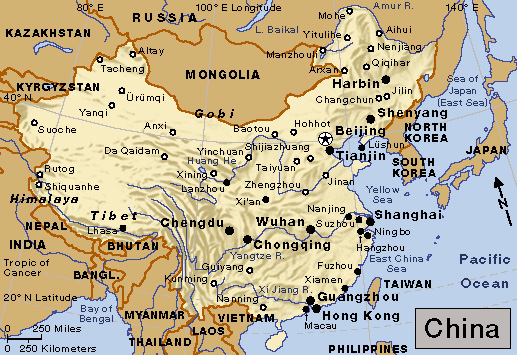Shanxi << shahn shee >> Province is a province in north-central China. It has an area of 60,700 square miles (157,100 square kilometers). Its name is sometimes spelled Shansi. Taiyuan is the province’s capital and largest city. Datong is the province’s second largest city. The vast majority of Shanxi’s people are Han Chinese.

Much of Shanxi is a plateau thickly covered with loess, a fertile, yellowish soil deposited by the wind. Mountains and deep river basins cover large areas. The Great Wall of China forms most of Shanxi’s northern border with Inner Mongolia. The Huang He (Yellow River) forms Shanxi’s western border with Shaanxi Province. The river also forms part of Shanxi’s southern border with Henan Province. The Fen River, a stream that flows into the Huang He, runs through Shanxi. The province has cold winters and rainy summers.
Shanxi has large deposits of coal and iron ore. Its main crops include apples, corn, cotton, dates, grapes, millet, pears, sorghum, and wheat. Many farmers raise cattle, chickens, goats, hogs, and sheep. The major industries in the province manufacture cement, chemicals, iron and steel, machinery, and textiles.
Shanxi was part of Jin, a state that rose to importance within the empire ruled by the Zhou dynasty (1045-256 B.C.). A dynasty is a series of rulers from the same family. During the 400’s B.C., Jin broke into three parts. Later, Shanxi was ruled by the Qin (221-206 B.C.) and Han (206 B.C-A.D. 220) dynasties, and then by several foreign dynasties. One of these, the Northern Wei (386-534), ruled northern China from its capital at present-day Datong. Taiyuan—then called Jinyang—was the base for the founding of the Tang dynasty (618-907).
From the mid-900’s to the mid-1300’s, parts of Shanxi were ruled by the Khitans, Ruzhen (also known as Jurchen), and Mongols. After the fall of the Qing dynasty (1644-1912), the province was ruled for many years by the warlord Yan Xishan, also spelled Yen Hsi-Shan. The Communists took control of Shanxi in 1949.
